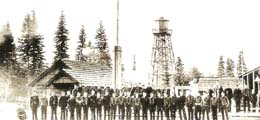On May 20, 1933, Civilian Conservation Corps (CCC) Camp Darrington opens a half mile north of the town of Darrington in Snohomish County. Designated as a forest service camp, it will undertake a wide variety of projects that will benefit out-of-work young men and their families throughout the long years of the Great Depression. It will serve several thousand enrollees over the years, providing jobs and creating structures in the national forest nearby, making roads, and fighting fires. It will close in 1942.
Young Men and Their Tents
On the rainy afternoon of May 17, 1933, 22 young men arrived in an old Model T mail truck at a forested spot a half-mile north of Darrington. By day's end, they had erected four tents and a kitchen fly. Thus, less than two months after President Franklin D. Roosevelt signed the bill that created the Civilian Conservation Corps, these enrollees, their three officers, and three enlisted men put CCC Camp Darrington on the map. The next day they began to clear land and start building.
Under the leadership of Lieutenant B. Adams, over the next couple of weeks the CCC crew erected two barracks and a mess hall. The camp was planned as a main facility that could hold up to 200 men, and enrollment grew to 172 enrollees, additional officers, and a doctor. The Darrington group was assigned to the Forest Service; its initial work focused the Sauk and Siuattle truck trails.
By the end of June, all the buildings were completed and occupied. The mail truck was replaced with two Chevrolet trucks, badly needed to move enrollees to their work assignments and bring in supplies. Once the flagpole was up, Camp F-15, Darrington, began to look like it would stay.
"The country adjacent to the camp is rough, mountainous & accessible with great difficulty," an article in the Camp Darrington album stated. "Road building has, therefore, occupied the major portion of the man-days expended since the camp was first established." By 1938, some 41 miles of road were completed, the majority of it through solid rock.
Eventually, side camps were established at Verlot and Sauk.
Three C’s Memories
Camp Darrington was in a rugged area, but the work and the camp life inspired the men. Carl Pearson joined Company 934 at the camp in July 1938. He later reflected:
“I was fortunate to be assigned under Claude Brazelton construction crew. Mr. Brazelton was a very competent builder in all phases. The forest Service was setting up a new headquarters compound, moving a few older buildings on to new foundations and building new shops, etc. We had a very compatable [sic] hard working crew and though our main work was carpentering, we also did plumbing, electrical wiring, bricklaying and naturally, cement work, as the need arose. This was valuable experience for us all. We were also encouraged to take free correspondence courses in these fields, which most of us took advantage” (“Carl P. Pearson Recollects,” Vic and Mae Civilian Conservation Corps Collection).
Thor Pearson remembers building a fire-watch on Miners Ridge. “This was a real paradise for us. The scenery was spectacular: And after work we would go hiking, There was deer all over, black bears were common. I once met a grizzly bear, and even came close to a mountain goat” (Camp Darrington, Vic and Mae Civilian Conservation Corps Collection).
In addition to fire-watching duties, the "CCC boys," as they were often called, had time off in the little town of Darrington. They enjoyed the camaraderie of the camp life with its mix of people from across the country.
Byron Reagan was also in company No. 934. “I enjoyed my days in the CCC and made many friends. We had good times as well as bad. One night a bunch of us were in Darrington and we saw a car that belonged to one of the guys from the office. He had said no one could fool him. He should have not said that. We picked the car up and carried it around in back. It took him threes days to find it (Byron Reagan, “CCC Memories”).
CCC workers were not allowed to have cars. Some of the camp officers thought they might have one anyway and park them in the little town of Darrington. One such officer was known as Snakey. Walt Bailey remembers that he “snuck around looking for such cars” (Bailey, March 26, 2008).
Celebrating the Past
On March 31, 2008, surviving enrollees, family members, and supporters preserving the heritage of the CCC in Washington state, gathered to celebrate the 75th anniversary of the Civil Conservation Corps. Held at the Mansford Grange just outside of town on the very spot of Camp Darrington, the enrollees were honored for building shelters, the Squire Creek and Clear Creek trails, and the Mountain Loop Highway.
After so many years, the CCCs are still remembered with affection for their good works in the national parks and forests, works the public enjoys to this day.

